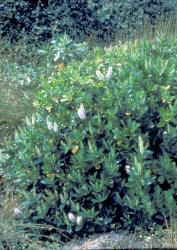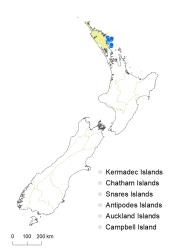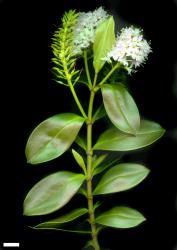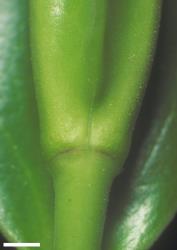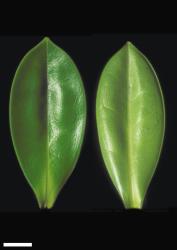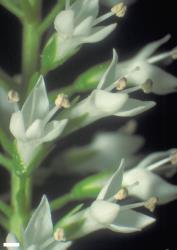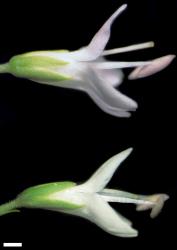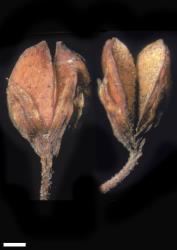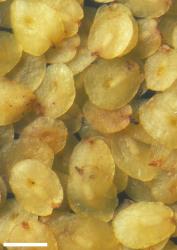- Taxon
- Gallery
- ≡ Hebe bollonsii (Cockayne) Cockayne & Allan, Trans. New Zealand Inst. 57: 15 (1926)
Bushy shrub to 2.5 m tall. Stems erect, eglandular-puberulent, hairs uniform. Leaf bud distinct, its leaves appressed at margins until fully grown; sinus absent. Leaves opposite-decussate, erect to spreading; lamina coriaceous, usually oblanceolate to obovate, sometimes oblong to elliptic, 14–130 mm long, 8–42 mm wide, dull or glossy, dark green above, pale green to green beneath, midrib and secondary veins evident; surfaces glabrous or eglandular-hairy along midrib above; margin glabrous or ciliolate, entire; apex obtuse to sub-acute and often shortly acuminate; base cuneate; petiole absent. Inflorescence a lateral raceme, 35–150 mm long; flowers crowded, 24–125, all bisexual; bracts alternate or loosely whorled, or the lowermost pair opposite, lanceolate to linear-lanceolate or ovate, < pedicels; pedicels erecto-patent, 1.0–6.5 mm long, eglandular-hairy all around. Calyx lobes 4, acute to acuminate, 2.5–3.5 mm long, equal, mixed glandular- and eglandular-ciliolate and rarely hairy outside. Corolla 6.5–8.0 mm diameter; tube white, 3–5 mm long, ≥ calyx, eglandular-hairy inside and often also outside; lobes 4, flushed pale purple, fading white, erecto-patent to spreading, sub-equal to unequal, narrowly lanceolate to elliptic, 3.5–4.5 mm long, acute to sub-acute; nectar guides absent. Stamen filaments white, 3.8–7.0 mm long; anthers pale purple, fading brown. Style glabrous, 5.5–8.5 mm long. Capsules latiseptate, sub-acute, glabrous, 2.5–5.5 mm long, 1.8–4.0 mm at widest point. Seeds broadly ellipsoid, flattened, smooth, straw-yellow to brown, 1.0–1.7 mm long.
Veronica bollonsii is quite distinctive, characterised by leathery, bright green, usually obovate leaves with visible lateral veins, erect inflorescences, narrow acute to acuminate calyx lobes, and acute corolla lobes. In leaf shape, plants are similar to some coastal plants of V. stricta (particularly forms recognised as var. macroura), which can be distinguished by smaller, more numerous flowers, narrower corolla lobes, which are more rounded at the apex, longer corolla tubes, and smaller capsules. Some plants of V. pubescens subsp. sejuncta may be similar, but they have a sinus in the leaf bud.
North Island: Northland (Poor Knights Is., Hen and Chickens Is., and the nearby east coast between Mimiwhangata Bay and Tutukaka).
Coastal and near-coastal scrub and forest. Recorded elevations range from 0 to 152 m.
Flowers: October–February, extending to September; fruits: November–February (persisting all year).
2n = 40 (see Bayly & Kellow 2006, as Hebe bollonsii).
Veronica bollonsii is classified in V. subg. Pseudoveronica sect. Hebe and the informal group “Occlusae” (Albach & Meudt 2010; Bayly & Kellow 2006).
Corolla lobes may be ciliate near the base.



